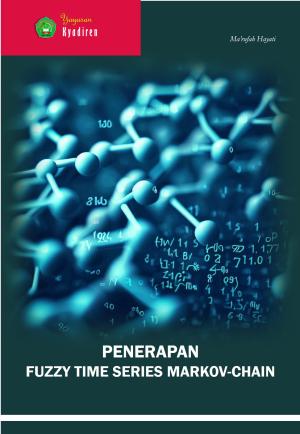

Penerapan Fuzzy Time Series Markov-Chain
Synopsis
Dalam buku ini, akan dibahas suatu metode peramalan yaitu fuzzy time series Markov-chain (FTSMC) merupakan metode yang memperhatian gejolak yang terjadi khusus nya pada nilai tukar Rupiah terhadap US Dollar dan data histori merupakan data linguistic, dengan mencari semesta pembicaraan U dari data, kemudian dari semesta pembicaraan tersebut dapat diperoleh beberapa interval yang kemudian transfer data kedalam suatu himpunan fuzzy yang telah ditentukan, lalu fuzzyfikasi ke data histori, mencari relasi logika fuzzy (FLR) dari hasil fuzzyfikasi, dari relasi logika fuzzy (FLR) yang di peroleh selanjutnya mencari grup relasi logika fuzzy (FLRG), dari grup relasi logika fuzzy yang diperoleh selanjutnya digunakan untuk mencari matrik transisi markov-chain, kemudian matrik yang di peroleh digunakan untuk peramalan. Untuk melihat Seberapa kinerja ramalan nilai tukar Rupiah terhadap US Dollar akan ditampilkan perbandingan MAPE metode fuzzy time series Markov-chain (FTSMC) dengan metode fuzzy time series (FTS) konvensional lainnya.
References
A. Zadeh, Lotfi. “The Role of Fuzzy Logic in the Management of Uncertainty in Expert Systems.” Fuzzy Sets and Systems 1, no. 1 (1983): 199–227. https://www.sciencedirect.com/science/article/pii/S0165011483800815.
Bank Indonesia. “Moneter: Informasi-Kurs Transaksi-BI,” n.d. https://www.bi.go.id/id/default.aspx.
Cai, Qisen, Defu Zhang, Wei Zheng, and C.H. Leung Stephen. “A New Fuzzy Time Series Forecasting Model Combined with Ant Colony Optimization and Auto-Regression.” Knowledge-Based Systems 74, no. 01 (2015): 61–68. https://doi.org/10.1016/j.knosys.2014.11.003.
Chen, S. M. Forecasting Enrollments Based on Fuzzy Time Series. Fuzzy Sets and Systems, 1996.
Chen, S.M, and C.C. Hsu. “A New Method to Forecast Enrollments Using Fuzzy Time Series.” International Journal of Applied Science and Engineering 2, no. 3 (2004): 234–44.
Davies, Glyn. A History of Money: From Ancient Times to the Present Day CYMRU-Contemporary German Writers Series. 3rd ed. Wales: University of Wales Press, 2008.
Duru, O. Limitation of Fuzzy Set Approach in Time Zeries Analisys (Is Fuzzy Time Series a Fallacy?). Istambul: Istambul Technical University, 2011.
Grass, Dieter, and TU Wien. “Numerical Computation of the Optimal Vector Field: Exemplified by a Fishery Model.” Journal of Economic Dynamics & Control 36, no. 10 (2012): 1626–58. https://doi.org/10.1016/j.jedc.2012.04.006.
Harel, Michel, Joseph Ngatchou-Wandji, Livasoa Andriamampionona, and Victor Harison. “Weak Convergence of Nonparametric Estimators of the Multidimensional and Multidimensional-Multivariate Renewal Functions on Skorohod Topology Spaces.” Stat Inference Stoch Process 24, no. 3 (2021). https://doi.org/10.1007/s11203-021-09263-3.
K. Rose, Andrew. “Exchange Rate Regimes in the Modern Era: Fixed, Floating, and Flaky.” Journal of Economic Literature 49, no. 3 (2011): 652–72. https://www.jstor.org/stable/23071725.
Khan, M. A. R, and D. S Poskitt. “Forecasting Stochastic Processes Using Singular Spectrum Analysis: Aspects of the Theory and Application.” International Journal of Forecasting 33, no. 1 (2017): 199–213. https://doi.org/10.1016/j.ijforecast.2016.01.003.
Mahmudah, Umi, and Muhamad Safiih Lola. “The Efficiency Measurement of Indonesian Universities Based on a Fuzzy Data Envelopment Analysis.” Open Journal of Statistics 6, no. 6 (2016): 1050–66. https://doi.org/10.4236/ojs.2016.66085.
Raj Singh, Shiva. “A Robust Method of Forecasting Based on Fuzzy Time Series.” Applied Mathematics and Computation 188, no. 1 (2007): 472–84. https://doi.org/10.1016/j.amc.2006.09.140.
Rajasekaran, S, and G. A Vijayalakshmi Pai. Neural Networks, Fuzzy Systems and Evolutionary Algorithms: Synthesis and Applications. India: Prentice-Hall of India Pvt.Ltd, 2017.
Sam’an, Muhammad, and Alamsyah Alamsyah. “Implementasi Fuzzy Inference System Sebagai SistemPengambilan Keputusan Pemilihan Program Studi DiPerguruan Tinggi.” UNNES Journal of Mathematics 4, no. 1 (2015): 68–74. https://journal.unnes.ac.id/sju/index.php/ujm/article/view/7420/5137.
Sheynin, Oscar. “Markov: Integrity Is Just As Important As Scientific Merits.” NTM International Journal of History & Ethics of Natural Sciences Technology & Medicine 15, no. 4 (2007): 289–94. https://doi.org/10.1007/s00048-007-0271-0.
Song, Q, and B Chissom. Forecasting Enrollments with Fuzzy Time Series Part 1. Fuzzy Sets and System, 1993.
Song, Qiang, and Brad S. Chissom. “Forecasting Enrollments with Fuzzy Time Series—Part II.” Fuzzy Sets and Systems 62, no. 1 (1994): 1–8. https://doi.org/10.1016/0165-0114(94)90067-1.
Sulastri, Lilis. Studi Kelayakan Bisnis Untuk Wirausaha. Edited by Creative Team LaGood’s Publishing. 1st ed. Bandung: LGM - LaGood’s Publishing, 2016.
Tsaur, C.R. “A Fuzzy Time Series-Markov Chain Model With An Application To Forecast The Exchange Rate Between The Taiwan And Us Dollar.” International Journal of Innovative Computing, Information and Control 8, no. 7 (2012): 4931–4942. http://www.ijicic.org/ijicic-11-04029.pdf.
Tsaur, C.R, O.C.J Yang, and F.H Wang. “Fuzzy Relation Analysis in Fuzzy Time Series Model,.” Computers and Mathematics with Applications 49 (2005): 536–48. https://core.ac.uk/download/pdf/82424321.pdf.
Vivas-Cortez, Miguel, and Jorge Eliecer Hernandez. “On (m, h 1 , h 2 )−Convex Stochastic Processes Using Fractional Integral Operator.” Applied Mathematics & Information Sciences 12, no. 1 (2018): 1–9. https://doi.org/10.18576/amis/mh1h2*SP.
Yuli Ananta, Ahmadi, Rohadi Erfan, and Dimas Wahyu Wibowo. “Sistem Pendukung Keputusan Dengan Menerapkan Logika Fuzzy Dalam Menentukan Prioritas Calon Debitur.” SMARTICS Journal 3, no. 1 (2017): 2476–9754. https://doi.org/10.21067/smartics.v3i1.1932.
Zheng, Yun Zhuang Chia-Rong, Su, and Chang Shu-Chin. “The Effectiveness Of If-Madm (Intuitionistic-Fuzzy Multi-Attribute Decision-Making) For Group Decisions: Methods And An Empirical Assessment For The Selection Of A Senior Centre.” Technological and Economic Development of Economy 25, no. 2 (2019): 322–64. https://doi.org/10.3846/tede.2019.8399.
Zhifeng, Dai, and Mi Yang Tingyu Li. “Forecasting Stock Return Volatility: The Role of Shrinkage Approaches in a Data-Rich Environment.” Journal of Forecasting 41, no. 1 (2021): 32. https://doi.org/10.1002/for.2841.

Downloads
Published
Categories
License

This work is licensed under a Creative Commons Attribution-NonCommercial-ShareAlike 4.0 International License.






